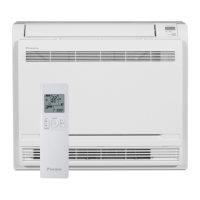SiBE121021_C Function of Thermistor
Function and Control 111
3. In cooling operation, the outdoor heat exchanger thermistor is used for high pressure
protection.
(2) Discharge
Pipe Thermistor
1. The discharge pipe thermistor is used for controlling discharge pipe temperature. If the
discharge pipe temperature (used in place of the inner temperature of the compressor) rises
abnormally, the operating frequency becomes lower or the operation halts.
2. The discharge pipe thermistor is used for detecting disconnection of the discharge pipe
thermistor.
(3) Gas Pipe
Thermistor
1. In cooling operation, the gas pipe thermistor is used for gas pipe isothermal control. The
system controls electronic expansion valve opening so that the gas pipe temperature in each
room becomes equal.
(4) Indoor Heat
Exchanger
Thermistor
1. The indoor heat exchanger thermistor is used for controlling target discharge pipe
temperature. The system sets the target discharge pipe temperature according to the
outdoor and indoor heat exchanger temperature, and controls the electronic expansion valve
opening so that the target discharge pipe temperature can be obtained.
2. In cooling operation, the indoor heat exchanger thermistor is used for freeze-up protection
control. If the indoor heat exchanger temperature drops abnormally, the operating frequency
becomes lower or the operation halts.
3. In cooling operation, the indoor heat exchanger thermistor is used for anti-icing function. If
any of the following conditions are met in the room where operation halts, it is assumed as
icing.
The conditions are
Tc
≤
– 1° C
Ta – Tc
≥
10° C
where Ta is the room temperature and Tc is the indoor heat exchanger temperature.
4. In heating operation, the indoor heat exchanger thermistor is used for heating peak-cut
control. If the indoor heat exchanger temperature rises abnormally, the operating frequency
becomes lower or the operation halts.
5. In heating operation, the indoor heat exchanger thermistor is used for detecting
disconnection of the discharge pipe thermistor. When the discharge pipe temperature
becomes lower than the maximum indoor heat exchanger temperature, the discharge pipe
thermistor is judged as disconnected.
6. When only one indoor unit is operating, the indoor heat exchanger thermistor is used for
subcooling control. The actual subcool is calculated with the liquid pipe temperature and the
indoor heat exchanger temperature. The system controls the electronic expansion valve
openings to obtain the target subcool.
7. The indoor heat exchanger thermistor is used for wiring error check function. The refrigerant
flows in order from the port A to detect the indoor heat exchanger temperature one by one,
and then wiring and piping can be checked.
(5) Liquid Pipe
Thermistor
1. When only one indoor unit is in heating, the liquid pipe thermistor is used for subcooling
control. The actual subcool is calculated with the liquid pipe temperature and the maximum
indoor heat exchanger temperature. The system controls the electronic expansion valve
openings to obtain the target subcool.
2. In heating operation, the liquid pipe thermistor is used for liquid pipes isothermal control. The
system controls electronic expansion valve opening so that the liquid pipe temperatures in
each room becomes equal.

